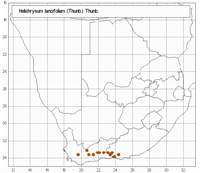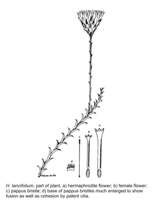Origin of name:
lancifolium = with lanceolate leaves
Diagnostic characters:
Large solitary headsWhite bracts, outer bracts golden-brown to red
Description:
Subshrub, branches weak, straggling, up to 600 mm long, closely leafy. Leaves imbricate, 6�18 x 1.5�4 mm, scarcely diminishing upwards on sterile twigs, abruptly passing into smaller, appressed bracts on flowering stems, linear-lanceolate, lower half appressed, webbed to stem, base broad, half-clasping, upper half flat or conduplicate, recurved, apex acute to acuminate, apiculate, both surfaces enveloped in closely woven silvery, silky indumentum. Heads heterogamous, turbinate, mostly c. 25�35 mm long, 40�50 mm across the radiating bracts, solitary at branchlet tips in upper leaf axils, branchlets peduncle-like, 50�200 mm long, closely bracteate, bracts appressed, uppermost tipped with papery brown scales passing into involucral bracts. Involucral bracts in c. 7 series, loosely imbricate, graded, inner much exceeding flowers, linear-lanceolate, acuminate, white usually overlaid pale to deep rose or crimson, outer bracts ovate to ovate-lanceolate, acute to acuminate, golden-brown. Receptacle very shortly honeycombed. Flowers 73�130, 20�35 female, 45�110 homogamous. Achenes 1.25 mm long, cylindric, with myxogenic duplex hairs. Pappus bristles many, about equaling corolla, tips subplumose, shaft barbellate to scabrid, bases lightly fused.
Flowering between September and January.
Distribution:
Found among shrubs and restiods. On the mountains flanking the Little Karoo, from the Baviaansberg and Bonteberg N. and E. of Ceres, and the Witteberg at Laingsburg, across the Klein and Groot Swartberg to the Baviaanskloof Mountains, Kouga Mountains, Outeniqua and Langekloof Mountains, above c. 700 m.
Fynbos Biome.
Notes:
H. stoloniferum and H. lancifolium are closely allied, but they are nearly allopatric; their areas appear to overlap only in the Baviaansberg NE. of Ceres.
H. lancifoliumis distinguished by its leaves, generally narrower and more pointed than those of H. stoloniferum, and by its heads, generally larger with more pointed inner involucral bracts. Peduncle-like flowering twigs seem to be a constant feature of H. lancifolium.
Taxonomy:
Literature:
Helichrysum lancifolium (Thunb.) Thunb., Fl. Cap. 662 (1823); Harv. in F.C. 3: 227 (1865); Moeser in Bot. Jb. 44: 322 (1910).
Type:
Cape of Good Hope, Thunberg (sheet 19304, UPS, holo.; S, iso.).
Synonym(s):
Xeranthemum lancifolium Thunb., Prodr. 152 (1800). Gnaphalium lancifolium (Thunb.) Sch. Bip. in Bot. Ztg 3: 169 (1845).
Helichrysum xeranthemoides DC., Prodr. 6: 178 (1838). Gnaphalium xeranthemoides (DC.,) Sch. Bip. in Bot. Ztg 3: 169 (1845). Lectotype: Cape, Langekloof, Dr�ge 2167 (G-DC; K; S; SAM, isolecto.).
Vouchers:
Acocks19928 (PRE); Compton 21142 (NBG); Esterhuysen 6587 (BOL; PRE); Oliver 5406 (PRE); Stokoe (SAM 68674).


